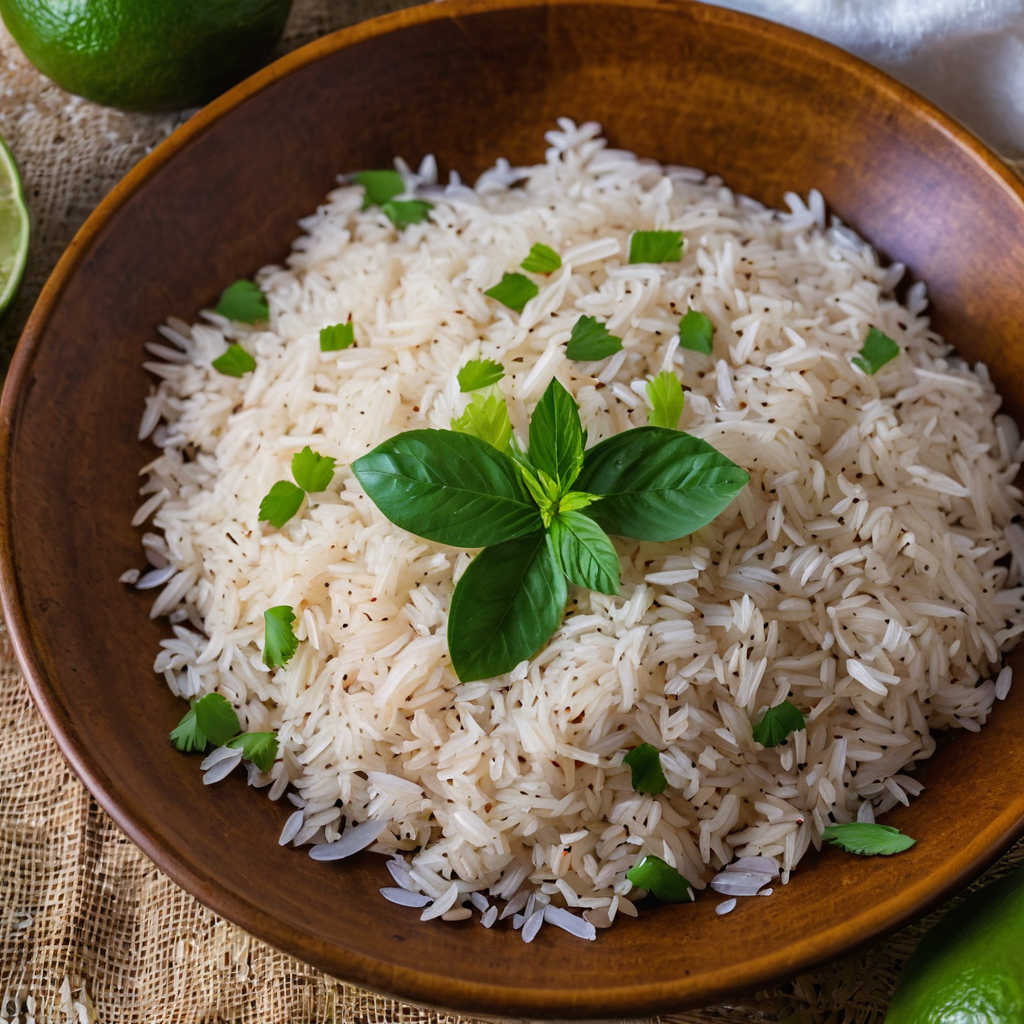A Delicious and Easy Recipe to Try at Home
If you’re looking for a simple yet delicious side dish that pairs perfectly with a variety of meals, look no further than coconut rice. This versatile dish is a staple in many Asian and tropical cuisines, and for good reason. With its fluffy texture and subtle coconut flavor, coconut rice is the perfect complement to spicy curries, savory stir-fries, and much more.
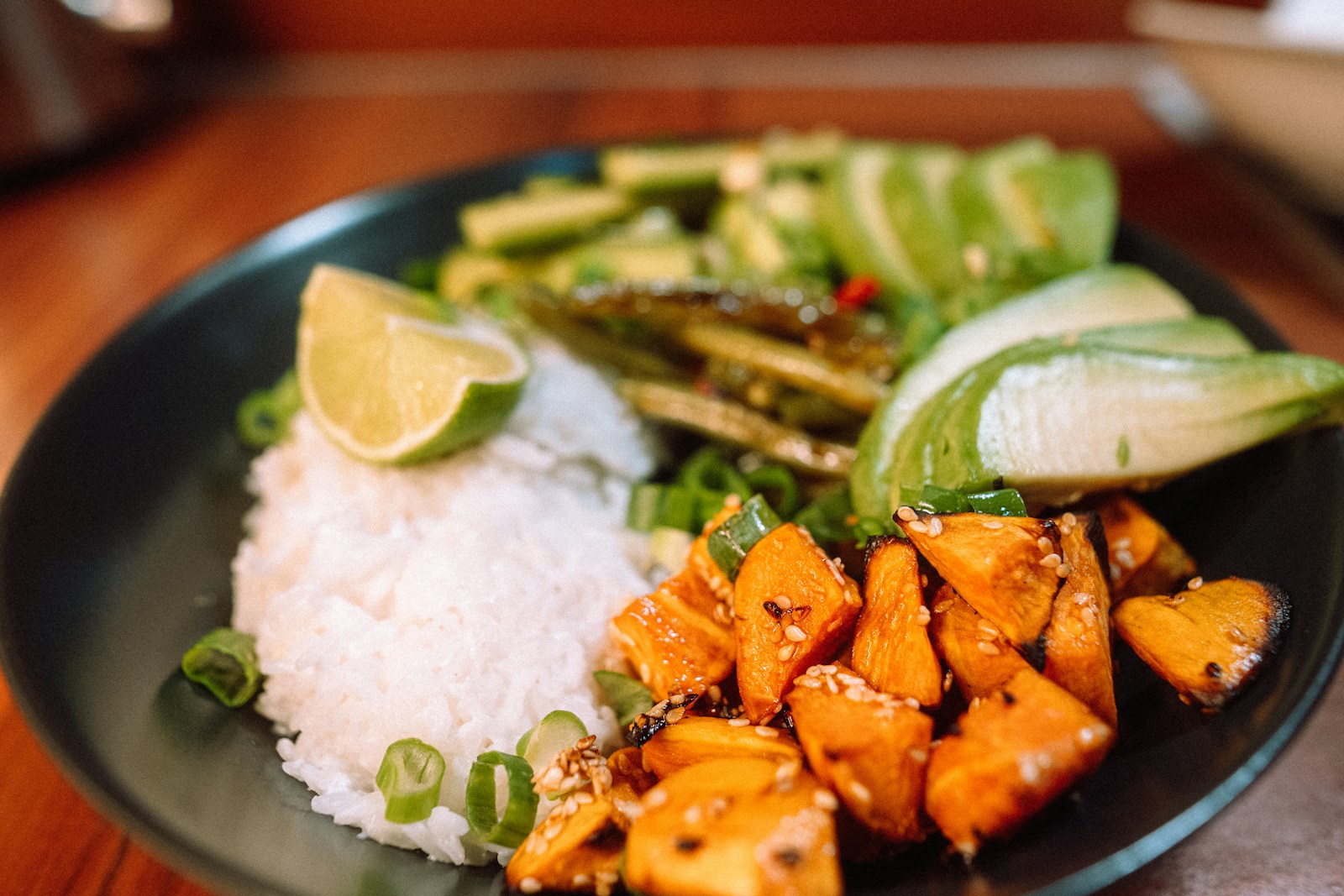
To make coconut rice, all you need is a few basic ingredients: rice, coconut milk, and water. Simply combine the ingredients in a pot, bring to a boil, then reduce the heat and let simmer until the rice is tender and fluffy. You can also add in additional ingredients like sugar, salt, or spices to customize the flavor to your liking.
One of the great things about coconut rice is its versatility. It can be served alongside a variety of dishes, from Thai-inspired curries to grilled meats and vegetables. Plus, it’s an easy way to add a touch of tropical flavor to any meal. So next time you’re looking for a simple yet flavorful side dish, give coconut rice a try!
What Is Coconut Rice?
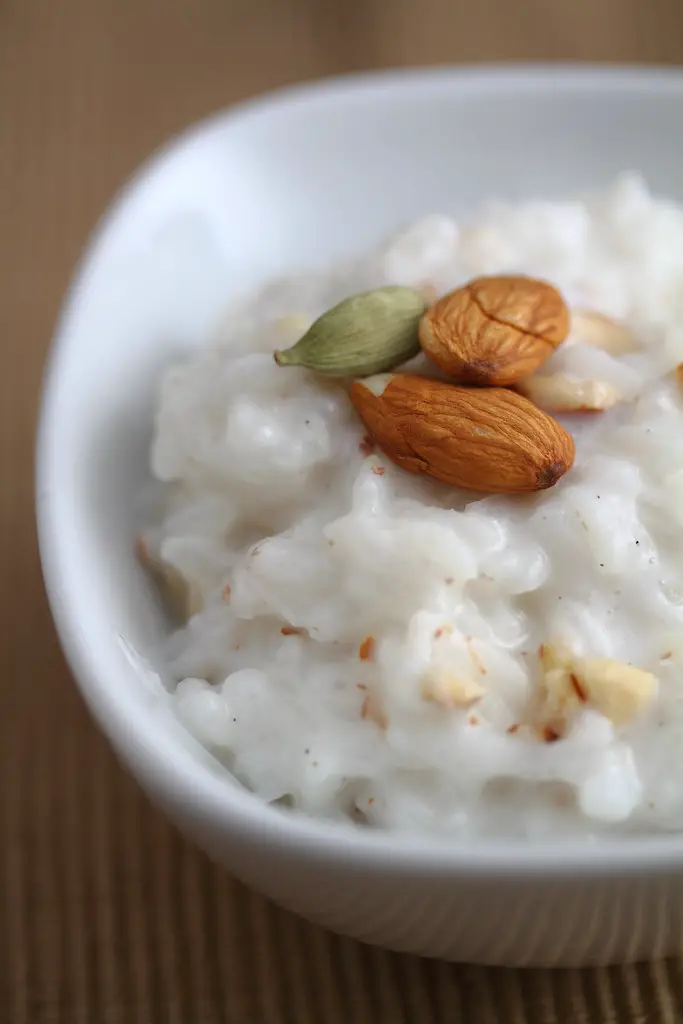
If you’re a fan of rice, you might want to try out coconut rice. This dish is a popular staple in many parts of the world, especially in Southeast Asia, South America, and the Caribbean. Coconut rice is made by cooking rice in coconut milk or coconut flakes, which gives it a unique and delicious flavor.
Origins and Cultural Significance
Coconut rice has been a part of many cultures for centuries. It is believed to have originated in Southeast Asia, where coconuts are abundant. In Thailand, it is known as “khao man gai” and is often served with chicken and a spicy dipping sauce. In the Caribbean, it is a popular side dish for many meals, while in South America, it is often served with seafood.
Coconut rice is not only a delicious dish but also has cultural significance in many places. In some cultures, it is served during special occasions such as weddings, festivals, and religious ceremonies. It is also a symbol of hospitality and is often served to guests.
Nutritional Profile
Coconut rice is a good source of carbohydrates and provides energy to the body. It is also rich in fiber, which helps to keep the digestive system healthy. Coconut milk used to cook the rice contains healthy fats that can help to improve cholesterol levels. Additionally, it contains essential vitamins and minerals such as iron, potassium, and magnesium.
However, it is important to note that coconut rice is also high in calories and saturated fats. Therefore, it should be consumed in moderation as part of a balanced diet.
If you’re interested in trying out coconut rice, you can find many recipes online that are easy to follow. You can also experiment with adding different spices and ingredients to make it your own.
Choosing the Right Ingredients
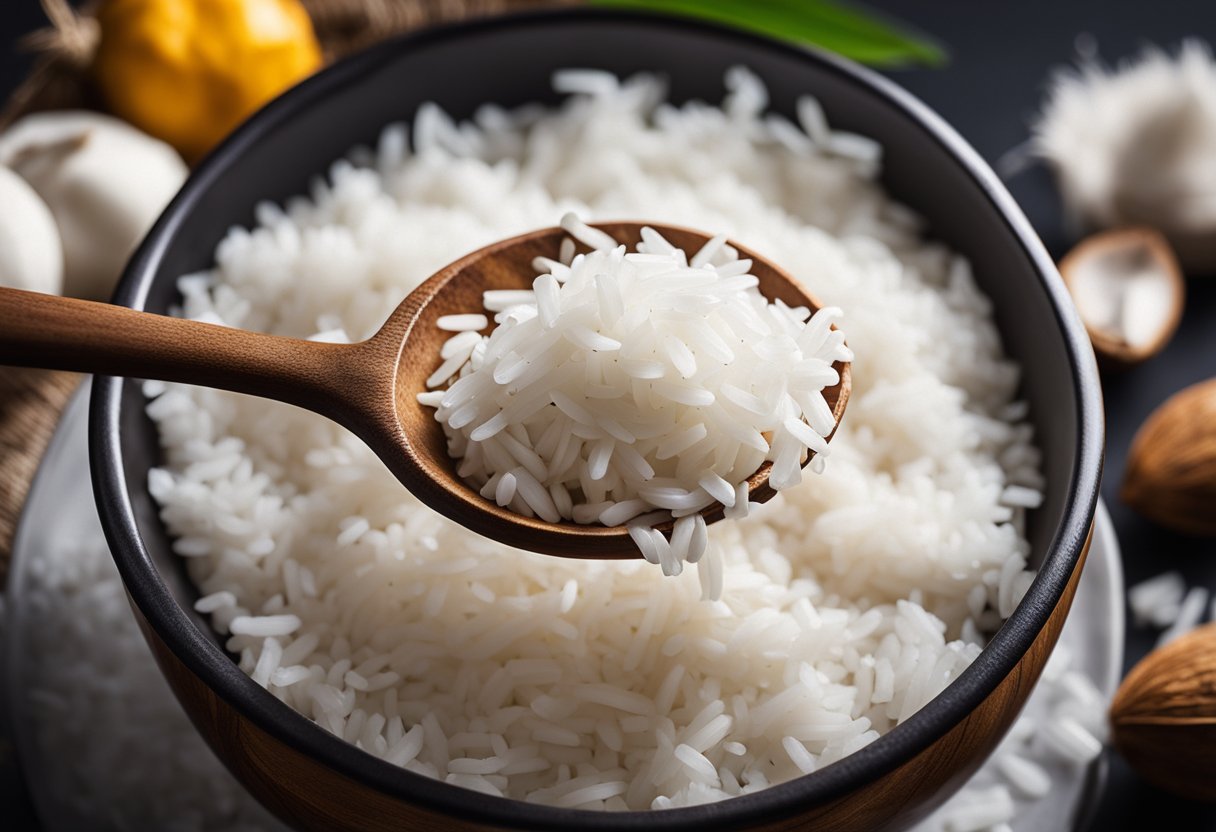
When it comes to making the perfect coconut rice, choosing the right ingredients is crucial. In this section, we will discuss the two main ingredients that make up this delicious dish: rice and coconut milk.
Types of Rice
The first step in making coconut rice is choosing the right type of rice. While any type of rice can be used to make coconut rice, some types are better suited than others. For example, long-grain rice tends to work well because it is less starchy and has a drier texture, which allows it to absorb the coconut milk without becoming too mushy. Basmati rice is also a popular choice because of its fragrant aroma and fluffy texture.
It is important to note that different types of rice may require different cooking times and amounts of liquid. Be sure to read the instructions on the package and adjust accordingly.
Coconut Milk vs. Coconut Cream
The second key ingredient in coconut rice is coconut milk. Coconut milk is made by blending coconut meat with water and then straining it to remove any solids. It has a creamy texture and a slightly sweet, nutty flavor that is perfect for making coconut rice.
However, some recipes call for the use of coconut cream instead of coconut milk. Coconut cream is made in a similar way to coconut milk, but it contains less water and more coconut solids, giving it a thicker consistency and a stronger coconut flavor.
When choosing between coconut milk and coconut cream, it ultimately comes down to personal preference. Coconut milk will give you a lighter, more delicate flavor, while coconut cream will give you a richer, more intense coconut flavor. Keep in mind that coconut cream is also higher in fat and calories than coconut milk.
In summary, choosing the right type of rice and the right coconut product is key to making perfect coconut rice. Experiment with different types of rice and coconut products to find the combination that you enjoy the most.
Preparation Techniques
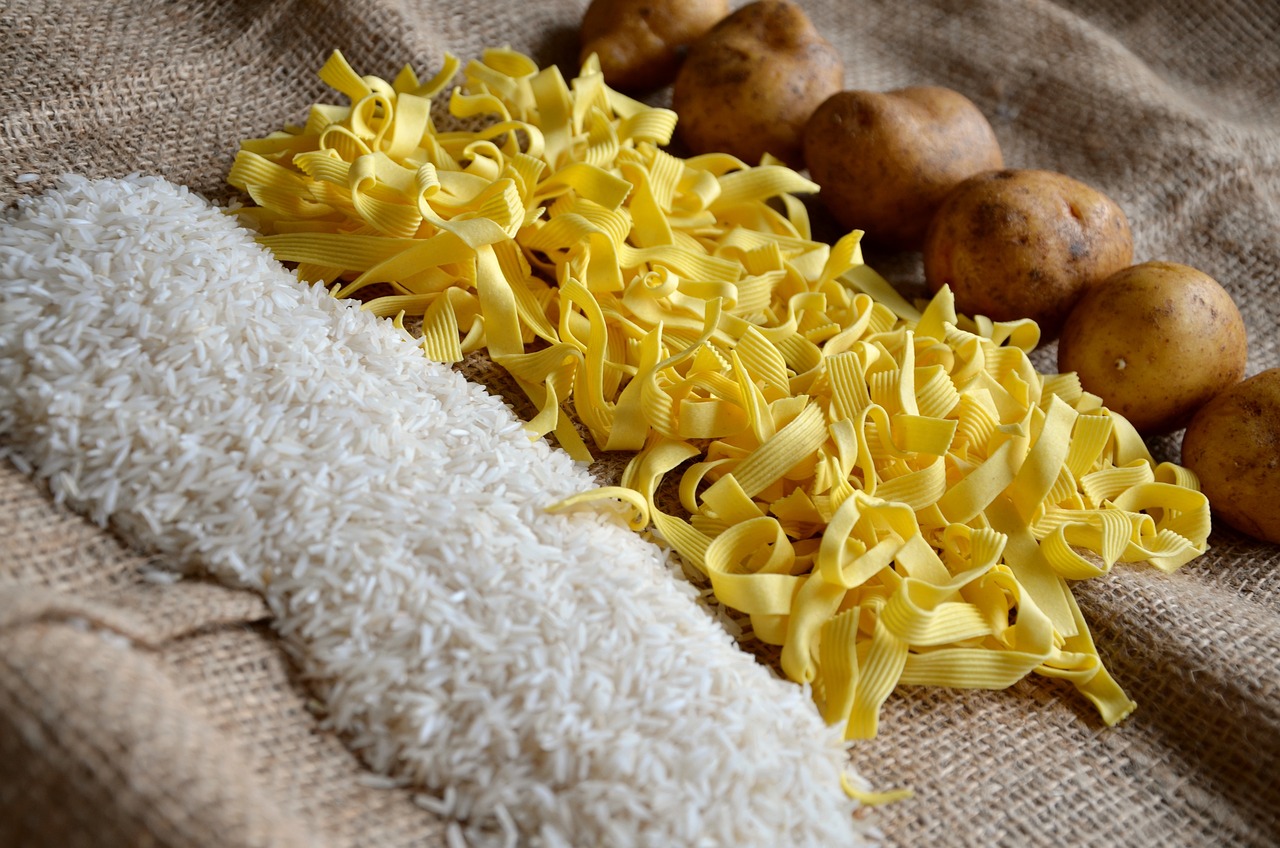
Rinsing and Soaking Rice
Before cooking coconut rice, it is important to rinse and soak the rice. Rinsing the rice removes excess starch and prevents the rice from becoming too sticky. Soaking the rice helps to ensure that the grains cook evenly and absorb the coconut milk and other flavors.
To rinse the rice, place it in a fine mesh strainer and rinse under cold running water until the water runs clear. Then, soak the rice in cold water for at least 30 minutes. This step is optional, but it will help to ensure that the rice is fluffy and not too sticky.
Cooking Methods
There are several methods for cooking coconut rice, including stovetop, rice cooker, and oven. Each method has its own advantages and disadvantages, so it is important to choose the method that works best for you.
Stovetop Method
To cook coconut rice on the stovetop, combine the rinsed and soaked rice with coconut milk, water, and salt in a medium saucepan. Bring the mixture to a boil over high heat, then reduce the heat to low and cover the saucepan with a tight-fitting lid. Simmer the rice for 15-20 minutes, or until the liquid has been absorbed and the rice is tender.
Rice Cooker Method
To cook coconut rice in a rice cooker, combine the rinsed and soaked rice with coconut milk, water, and salt in the rice cooker. Follow the manufacturer’s instructions for cooking rice, and let the rice cooker do the work for you.
Oven Method
To cook coconut rice in the oven, combine the rinsed and soaked rice with coconut milk, water, and salt in a baking dish. Cover the dish with foil and bake in a preheated oven at 350°F for 25-30 minutes, or until the liquid has been absorbed and the rice is tender.
No matter which cooking method you choose, be sure to fluff the rice with a fork before serving. This will help to separate the grains and prevent the rice from becoming too sticky.
Flavor Enhancements
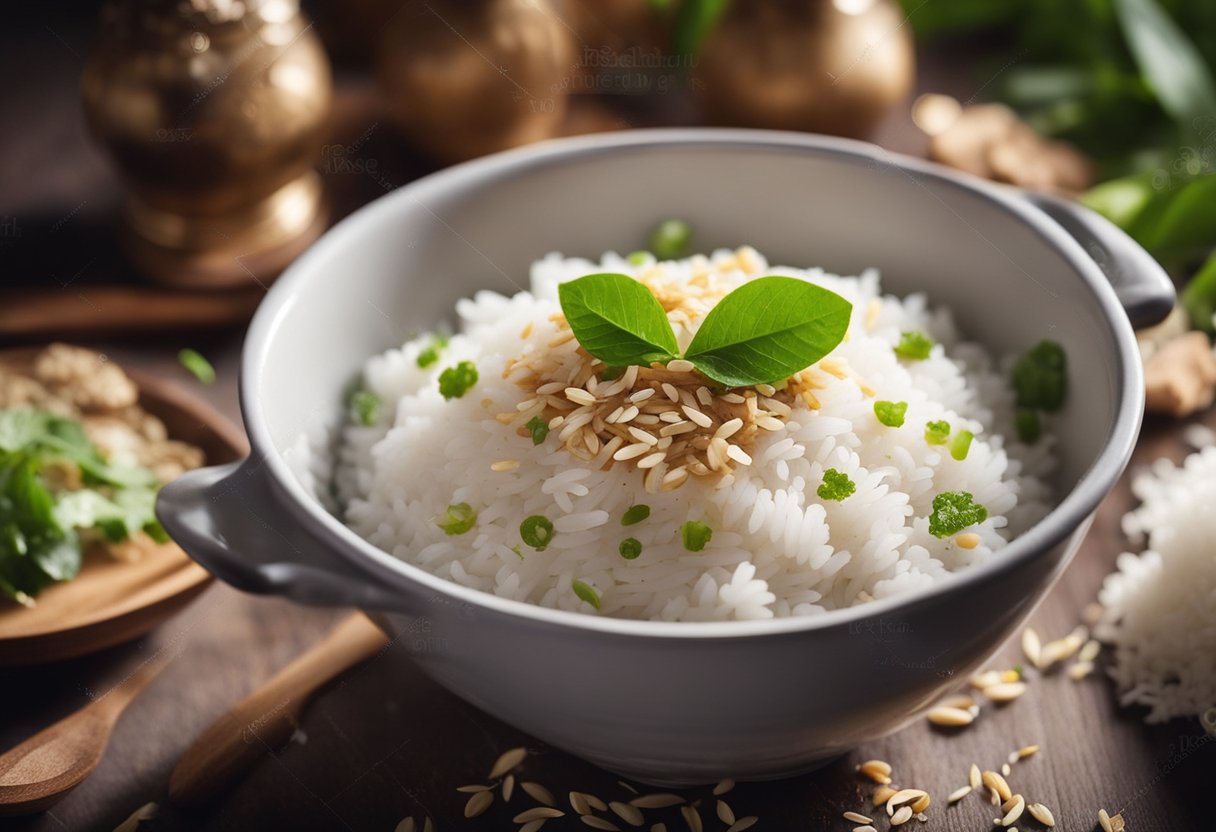
If you’re looking to add some extra oomph to your coconut rice, there are a variety of flavor enhancements you can try. Here are a few ideas to get you started:
Spices and Seasonings
One of the easiest ways to add flavor to your coconut rice is by incorporating spices and seasonings. Some popular options include:
- Cumin
- Coriander
- Turmeric
- Ginger
- Garlic
- Chili Powder
You can add these spices directly to the rice as it cooks, or you can toast them in a dry pan beforehand to bring out their flavors even more. You can also experiment with different combinations of spices to create your own unique blend.
In addition to spices, you can also try adding fresh herbs like cilantro, basil, or mint to your coconut rice for an extra burst of flavor.
Sweet vs. Savory Variations
Coconut rice can be made either sweet or savory, depending on your preferences. If you’re looking for a sweeter rice, you can add a bit of sugar or honey to the pot along with the coconut milk. You can also try adding diced fruit like mango or pineapple to the rice for a tropical twist.
For a more savory rice, you can add ingredients like soy sauce, fish sauce, or curry paste to the pot. You can also add vegetables like peas, carrots, or bell peppers to the rice for some extra color and nutrition.
No matter what flavor enhancements you choose, be sure to taste the rice as you go to make sure you’re happy with the final result. With a little experimentation, you’re sure to find a coconut rice recipe that you love.
Cooking Perfect Coconut Rice
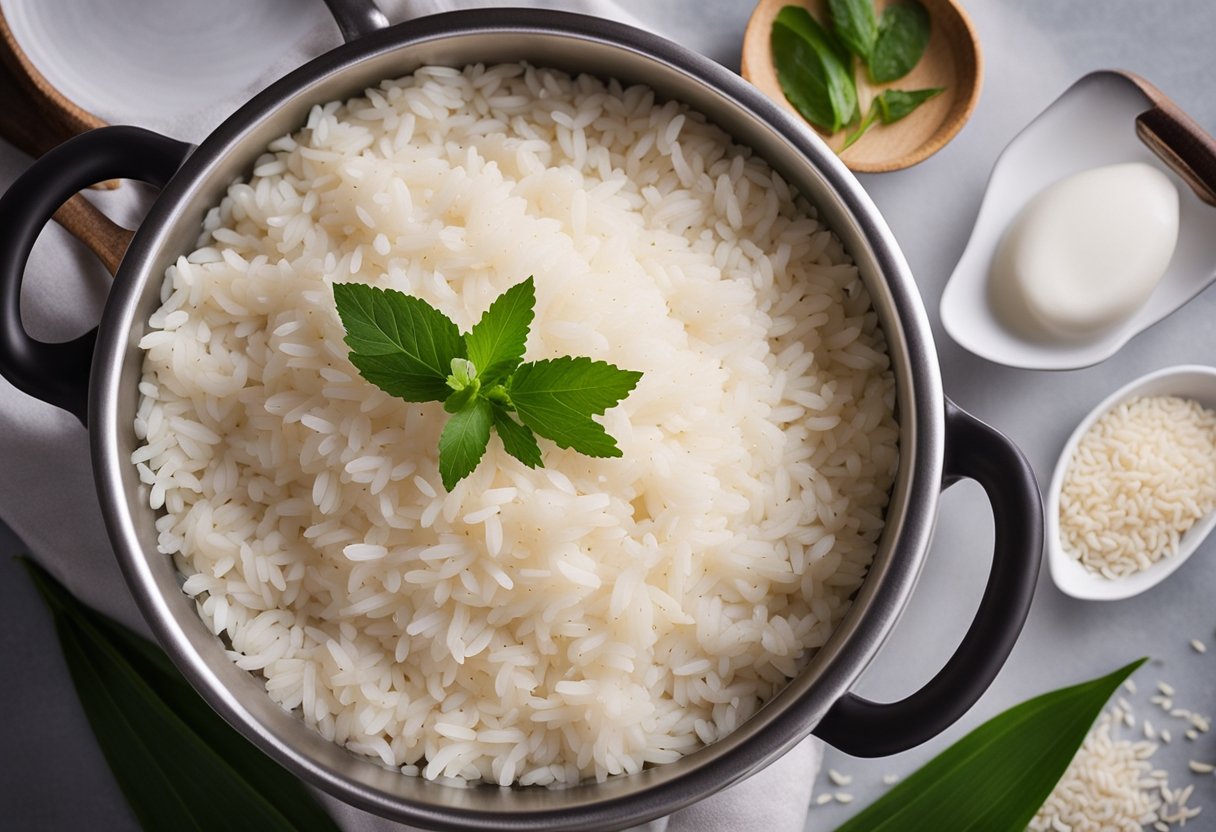
Coconut rice is a delicious and fragrant dish that is perfect for any occasion. It is a staple in many cuisines and can be cooked in a variety of ways. In this section, we will discuss how to cook perfect coconut rice using two methods: stovetop instructions and rice cooker tips.
Stovetop Instructions
Cooking coconut rice on the stovetop is a simple and straightforward process. Here are the steps to follow:
- Rinse the rice: Rinse the rice in cold water until the water runs clear. This will remove any excess starch and prevent the rice from becoming too sticky.
- Add the ingredients: In a large saucepan, add the rice, coconut milk, water, salt, and sugar (if using). Stir well to combine.
- Bring to a boil: Bring the mixture to a boil over high heat, stirring occasionally.
- Reduce heat and simmer: Once the mixture is boiling, reduce the heat to low and cover the saucepan with a tight-fitting lid. Allow the rice to simmer for 18-20 minutes, or until the liquid is absorbed and the rice is tender.
- Fluff and serve: Remove the saucepan from the heat and let it sit, covered, for 5-10 minutes. Fluff the rice with a fork and serve.
Rice Cooker Tips
Cooking coconut rice in a rice cooker is even easier than on the stovetop. Here are some tips to help you get perfect results every time:
- Rinse the rice: Rinse the rice in cold water until the water runs clear.
- Add the ingredients: Add the rice, coconut milk, water, salt, and sugar (if using) to the rice cooker. Stir well to combine.
- Cook the rice: Set the rice cooker to the “white rice” setting and let it cook until it switches to “warm.” This should take about 20-25 minutes.
- Fluff and serve: Let the rice sit for 5-10 minutes before fluffing it with a fork and serving.
By following these simple instructions, you can make perfect coconut rice every time. Whether you prefer to cook it on the stovetop or in a rice cooker, this delicious and fragrant dish is sure to be a hit with your family and friends.
Common Mistakes to Avoid
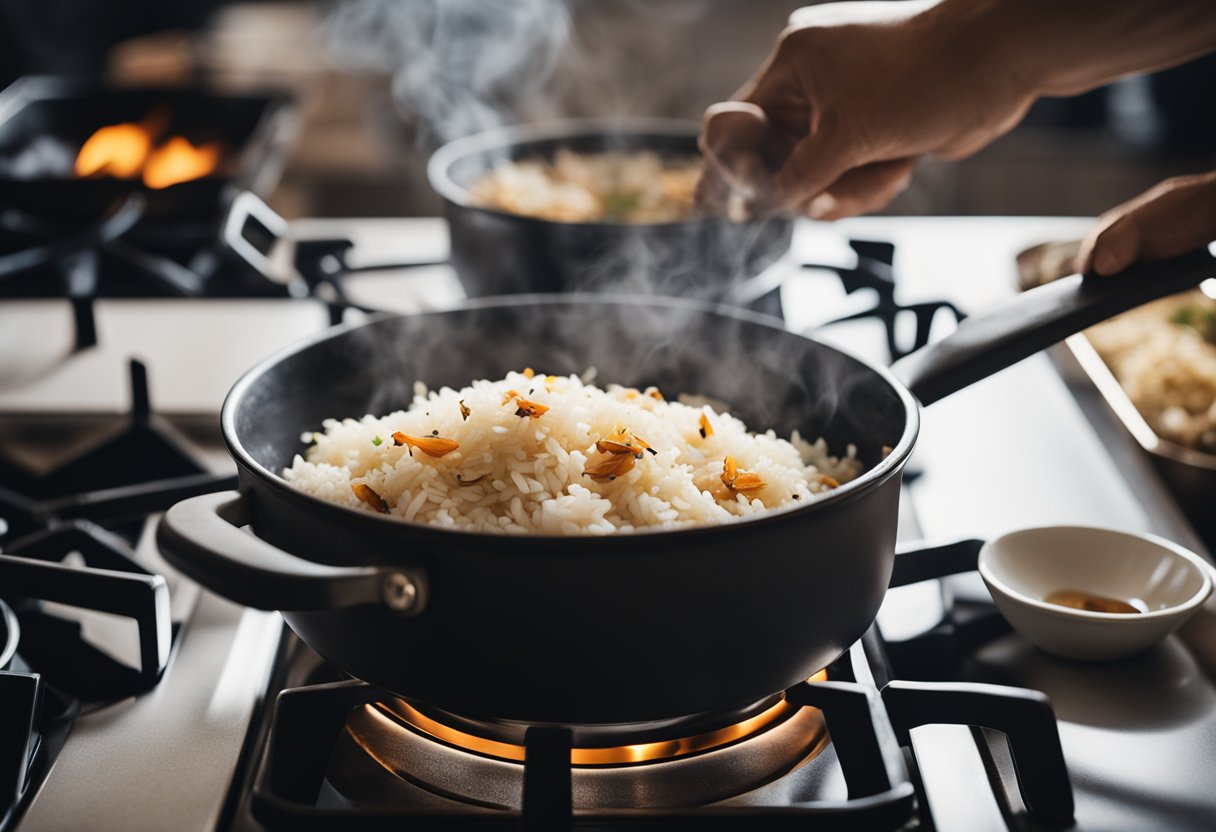
Coconut rice is a delicious and aromatic dish that can be enjoyed on its own or as a side dish. However, there are some common mistakes that people make when cooking coconut rice that can result in a less-than-perfect dish. Here are some mistakes to avoid when making coconut rice:
Using the Wrong Type of Rice
One of the most common mistakes when making coconut rice is using the wrong type of rice. It is important to use a long-grain rice such as basmati rice or jasmine rice. Short-grain rice such as sushi rice or arborio rice are not suitable for coconut rice as they have a different texture and absorb liquid differently.
Not Rinsing the Rice
Rinsing the rice before cooking it is an important step that many people skip. Rinsing removes excess starch and impurities from the rice, which can result in a better texture and flavor. To rinse the rice, place it in a fine-mesh strainer and rinse it under cold running water until the water runs clear.
Using Too Much Water
Using too much water can result in mushy and overcooked rice. The general rule of thumb is to use a 1:1.5 ratio of rice to liquid. For example, if you are using 1 cup of rice, you should use 1.5 cups of liquid. However, this may vary depending on the type of rice you are using, so be sure to check the package instructions.
Not Allowing the Rice to Rest
After the rice has finished cooking, it is important to let it rest for a few minutes before fluffing it with a fork. This allows the rice to absorb any remaining liquid and helps to prevent it from becoming sticky or clumpy.
Not Adding Enough Coconut Milk
Coconut milk is the star ingredient in coconut rice, so it is important to use enough of it. The general rule of thumb is to use a 1:1 ratio of rice to coconut milk. However, this may vary depending on the brand of coconut milk you are using, so be sure to check the label.
By avoiding these common mistakes, you can ensure that your coconut rice turns out perfectly every time.
Serving Suggestions
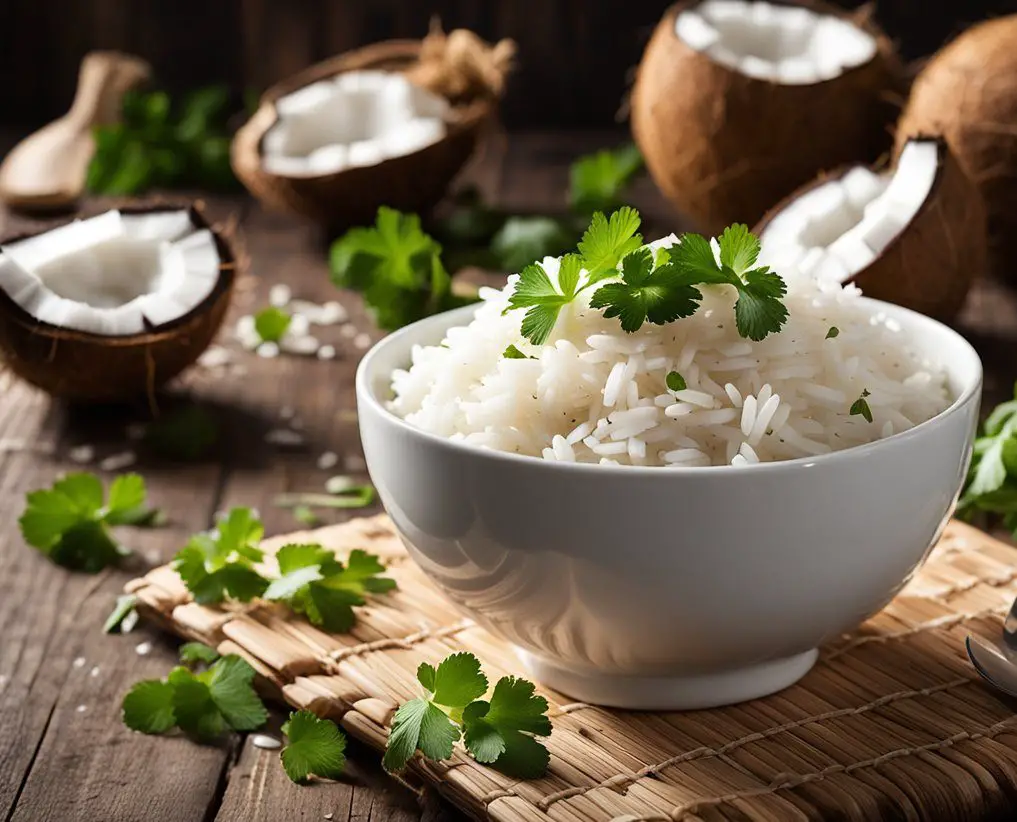
Complementary Dishes
Coconut rice is a versatile dish that pairs well with a variety of complementary dishes. Here are some suggestions to elevate your coconut rice dish:
- Curries: Coconut rice is a perfect accompaniment to curries of all kinds. The creaminess of the rice complements the spiciness of the curry, creating a perfect balance of flavors. Try pairing your coconut rice with Thai green curry or Indian chicken curry for a delicious meal.
- Grilled Meats: The nutty flavor of coconut rice pairs well with grilled meats. Try serving it with grilled chicken, steak, or shrimp for a tasty and satisfying meal.
- Roasted Vegetables: Coconut rice also pairs well with roasted vegetables. The sweetness of the coconut rice complements the earthiness of the vegetables. Try serving it with roasted sweet potatoes, carrots, or broccoli for a healthy and flavorful meal.
Presentation Tips
Presentation is key when it comes to serving coconut rice. Here are some tips to help you present your coconut rice dish in an appealing way:
- Garnish: Add a pop of color to your coconut rice dish by garnishing it with fresh herbs, such as cilantro or parsley. You can also add a sprinkle of toasted coconut flakes for added texture and flavor.
- Serve in a Coconut Shell: For a fun and tropical presentation, serve your dish in a coconut shell. Cut the top off a coconut, scoop out the flesh, and fill it with your coconut rice. This will not only impress your guests but will also add a unique flavor to your dish.
- Serve in a Bowl: This dish is a hearty dish that is best served in a bowl. Use a colorful bowl to make your dish pop and add some chopped vegetables or nuts on top for added texture and flavor.
In conclusion,This dish is a delicious and versatile dish that pairs well with a variety of complementary dishes. By following these serving suggestions, you can elevate your coconut rice dish and impress your guests with a beautiful and flavorful meal.
Storing and Reheating
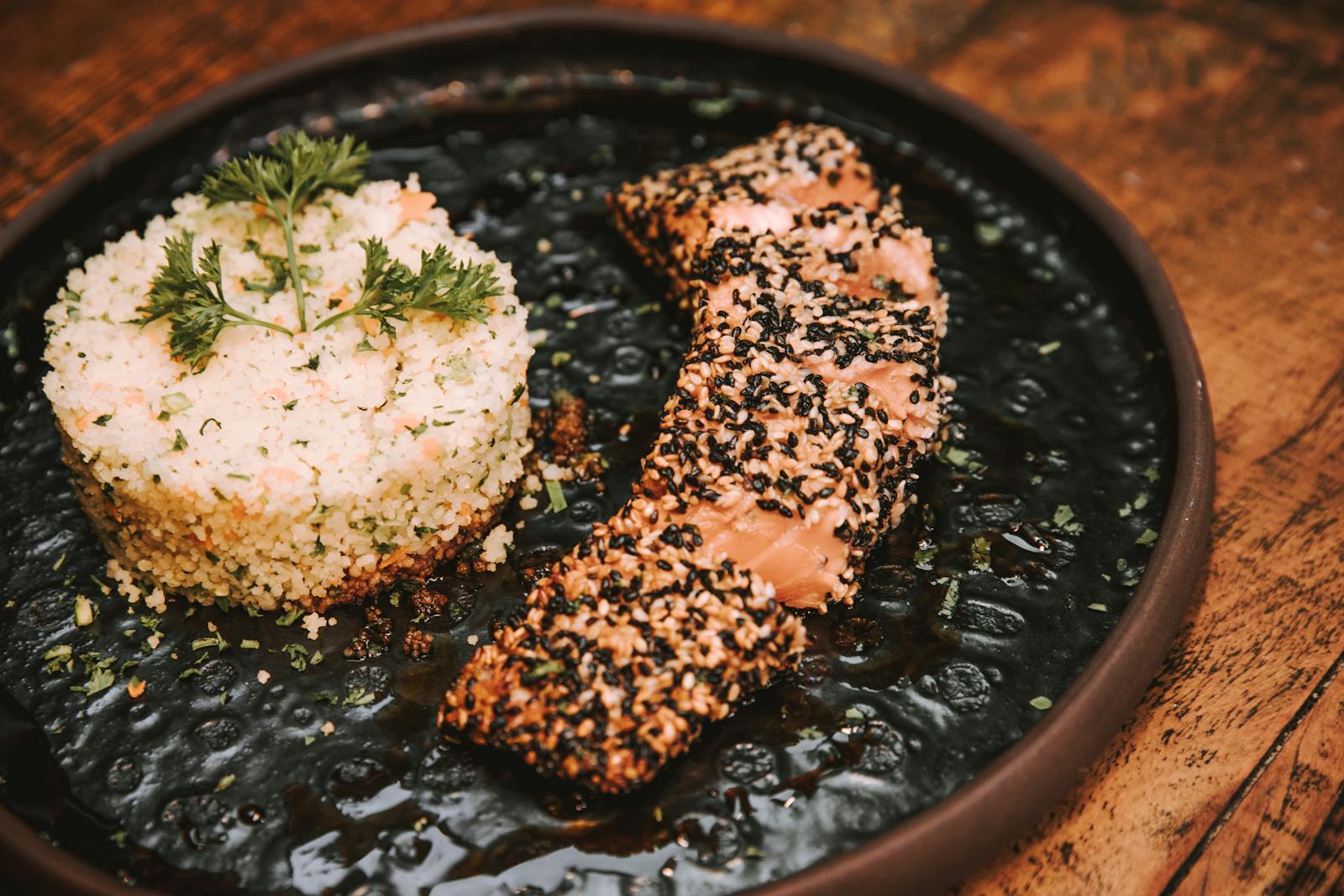
This dish can be stored and reheated easily, making it a great option for meal prep or leftovers. Here are some tips on how to store and reheat your dish:
Storing Coconut Rice
To store your dish, let it cool completely before transferring it to an airtight container or bag. You can store it in the refrigerator for up to 4-5 days. If you want to freeze your coconut rice, let it cool completely before transferring it to a freezer-safe, airtight container or bag. Freeze it for up to 3 months.
Reheating Coconut Rice
To reheat your recipe, you can either use the microwave or stovetop. Here are the steps for each method:
Microwave
- Transfer your recipe to a microwave-safe dish.
- Add a tablespoon or two of water to the rice to prevent it from drying out.
- Cover the dish with a microwave-safe lid or plastic wrap.
- Microwave on high for 1-2 minutes or until heated through.
Stovetop
- Heat a tablespoon of oil in a pan over medium heat.
- Add your recipe to the pan and stir to break up any clumps.
- Add a tablespoon or two of water to the pan to prevent the rice from sticking.
- Cover the pan with a lid and cook for 3-5 minutes or until heated through.
Remember to always reheat your dish to an internal temperature of 165°F or higher to ensure it’s safe to eat.
By following these simple steps, you can ensure that your dish stays fresh and delicious for days to come.
Health Benefits and Considerations
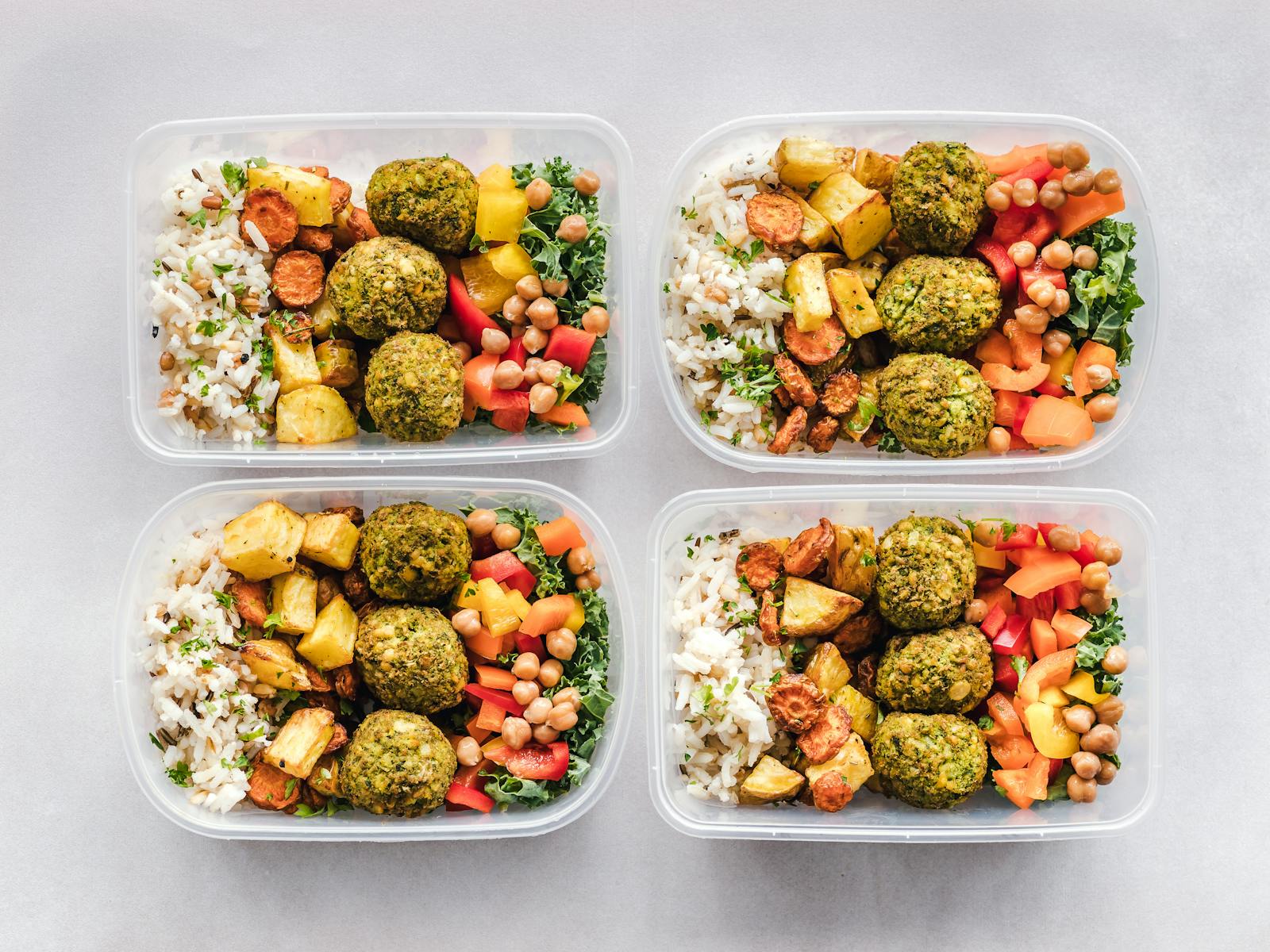
If you’re looking for a delicious and healthy alternative to plain rice, coconut rice may be just what you need. Here are some of the health benefits and considerations of This dish:
Health Benefits
- Rich in Fiber: It is a good source of fiber, which can help regulate digestion and promote feelings of fullness. One cup of cooked coconut rice contains about 2 grams of fiber.
- Gluten-Free and Dairy-Free: It is naturally gluten-free and dairy-free, making it a great option for people with food intolerances.
- Contains Essential Minerals: It contains minerals such as manganese, potassium, and phosphorus, which play important roles in bone health, energy metabolism, and cell function.
- May Boost Immunity: Coconut contains lauric acid, a type of fatty acid that has been shown to have antimicrobial properties. While more research is needed, some studies suggest that lauric acid may help boost immunity.
Considerations
- High in Calories: This dish is higher in calories than plain rice due to the addition of coconut milk. One cup of cooked it contains about 283 calories, compared to 205 calories in one cup of cooked white rice.
- High in Saturated Fat: Coconut milk is high in saturated fat, which can raise cholesterol levels and increase the risk of heart disease if consumed in excess. It’s important to consume This dish in moderation as part of a balanced diet.
- May Contain Added Sugar: Some recipes for This dish include added sugar, which can contribute to weight gain and other health issues if consumed in excess. Look for recipes that use natural sweeteners like maple syrup or honey, or skip the sweetener altogether.
Overall, it can be a nutritious and delicious addition to your diet when consumed in moderation as part of a balanced meal plan.
Adapting the Recipe for Dietary Restrictions
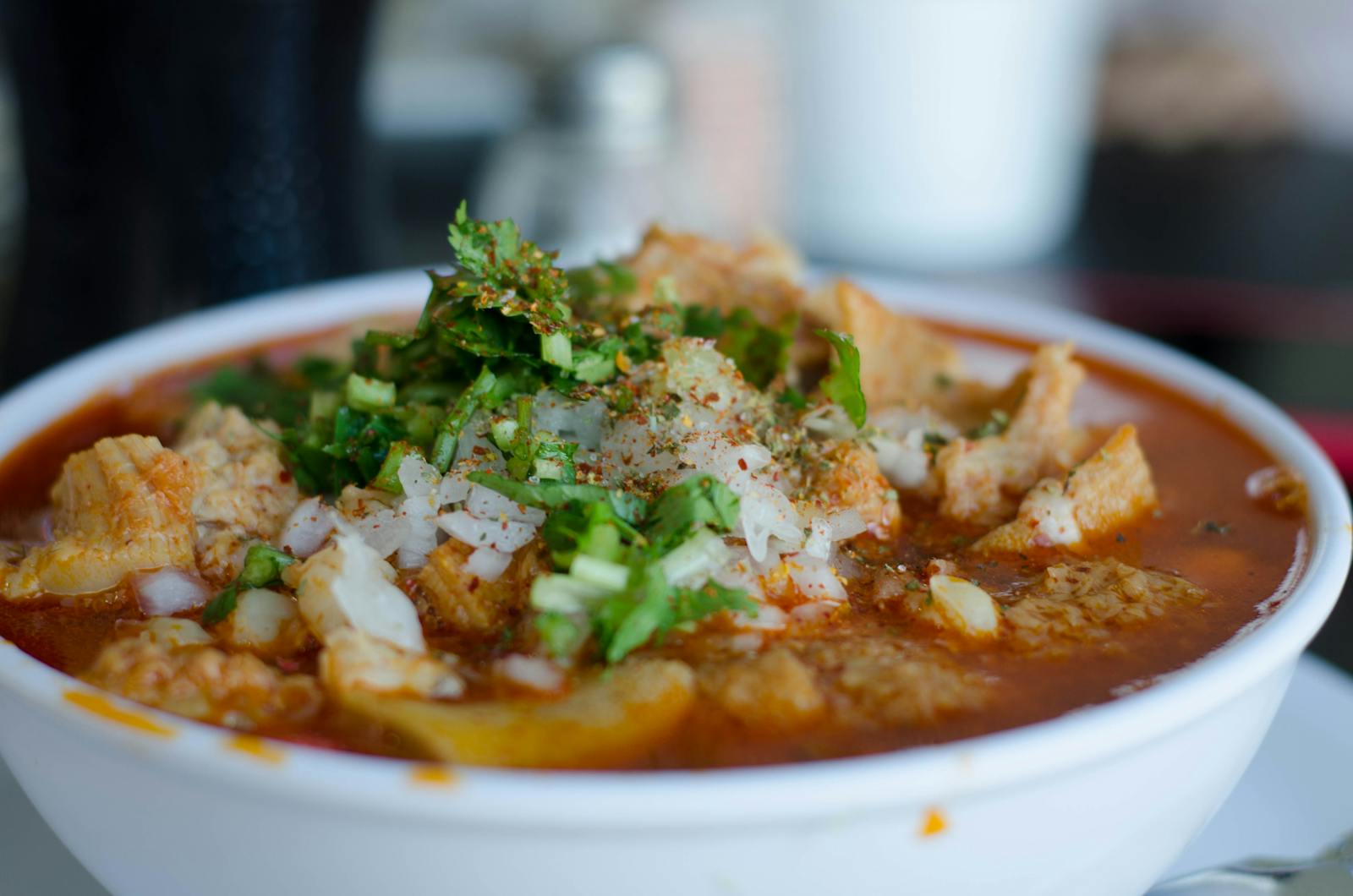
This dish is a delicious and versatile dish that can be enjoyed by many people, regardless of their dietary restrictions. With a few simple modifications, you can easily adapt this recipe to meet your dietary needs. Here are some tips for making vegan, gluten-free, and low-calorie variations of coconut rice.
Vegan and Gluten-Free Options
If you’re following a vegan or gluten-free diet, you’ll be happy to know that This dish can easily be made without any animal products or gluten-containing ingredients. To make vegan coconut rice, simply use a plant-based milk, such as almond milk or soy milk, in place of the regular milk or cream. You can also use a vegan butter or coconut oil instead of regular butter.
To make it gluten-free, be sure to use a gluten-free variety of rice, such as basmati or jasmine rice. You should also check the label of any other ingredients you’re using, such as the coconut milk or any seasonings, to ensure they are gluten-free.
Low-Calorie Variations
It is a flavorful and filling dish, but it can also be quite high in calories. If you’re looking for a lighter version of this dish, there are a few modifications you can make.
First, consider using a light coconut milk instead of regular coconut milk. This will significantly reduce the calorie and fat content of the dish. You can also use less coconut milk overall and substitute with water or broth to make the rice less creamy.
Another option is to use a smaller amount of rice and more vegetables, such as carrots, peas, and bell peppers. This will add more nutrients and fiber to the dish while also reducing the overall calorie count.
Finally, be mindful of any additional ingredients you add to the dish, such as sugar or butter. These can quickly add up in terms of calories and should be used sparingly.
With these tips, you can easily adapt it to meet your dietary needs and preferences. Whether you’re vegan, gluten-free, or watching your calorie intake, you can still enjoy this delicious and versatile dish.
Exploring Regional Variations
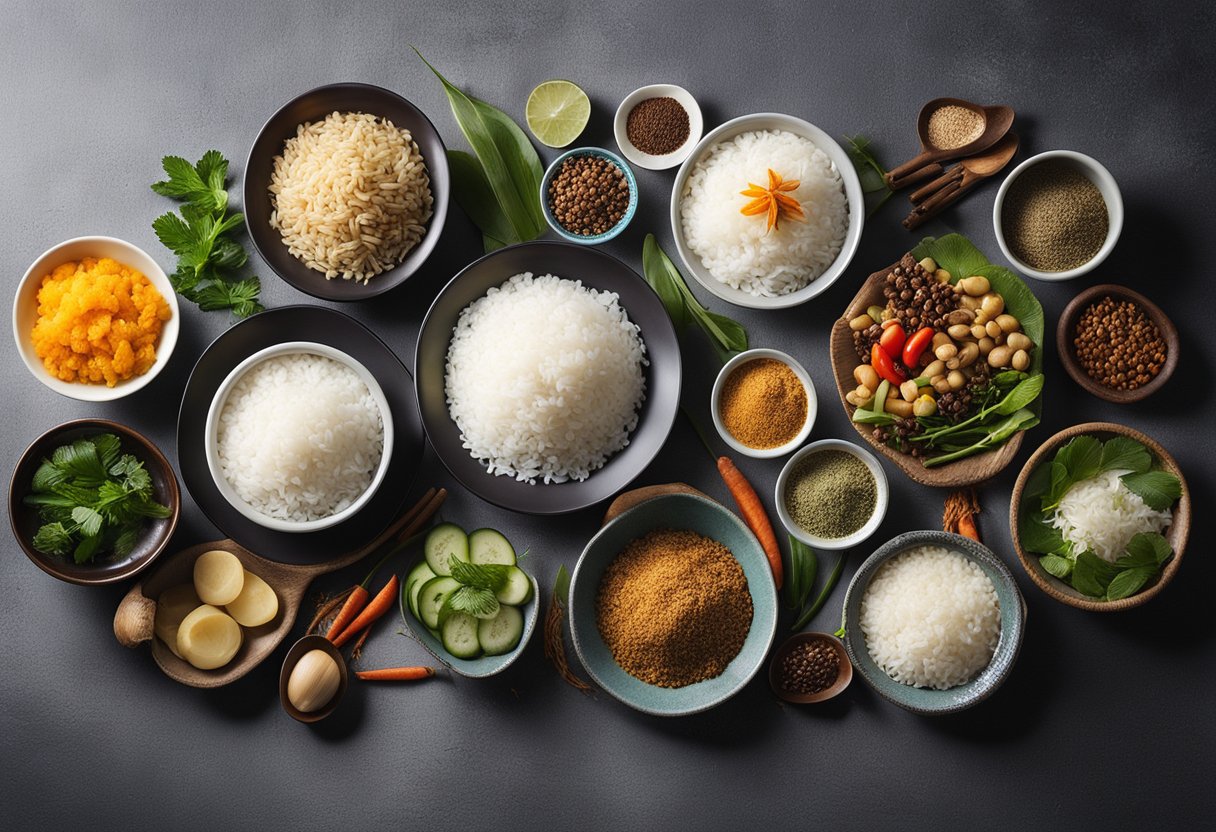
This dish is a dish that is enjoyed in many different regions of the world. Each region has its own unique take on this classic dish, incorporating local ingredients and spices to create a truly unique flavor profile. In this section, we will explore some of the regional variations of coconut rice.
Caribbean Styles
In the Caribbean, This dish is a staple dish that is often served with seafood or meat. The rice is cooked in coconut milk and seasoned with spices such as thyme, garlic, and scallions. Some variations of Caribbean-style also include beans or peas, which add a nice texture and flavor to the dish.
Jamaican-style and peas is a popular variation of this dish. It is made with pigeon peas, which are cooked with the rice in coconut milk and seasoned with garlic, thyme, and scallions. The result is a flavorful and aromatic dish that is perfect for any occasion.
South Asian Twists
In South Asia, This dish is often served as a sweet dish for breakfast or dessert. It is made with sticky rice, coconut milk, and sugar, and is often flavored with cardamom, saffron, or rose water.
Another popular variation of South Asian-style it is biryani. Biryani is a rice dish that is typically made with meat or vegetables and a variety of spices. Coconut milk is added to the rice to give it a rich and creamy texture, and the dish is often garnished with nuts and dried fruits.
Whether you prefer the savory flavors of the Caribbean or the sweet and aromatic flavors of South Asia, This dish is a versatile dish that can be enjoyed in many different ways. So why not try making your own version of this delicious dish today?
Frequently Asked Questions
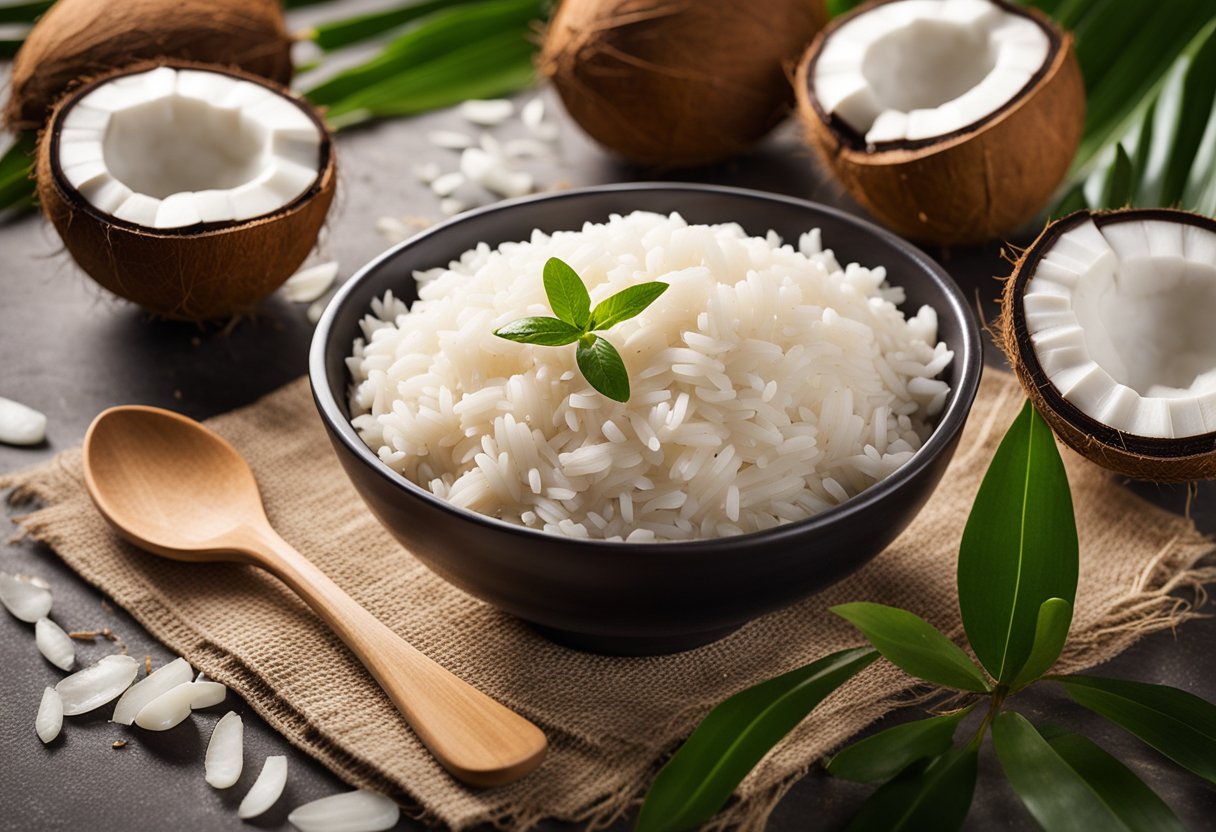
What are the key ingredients in a traditional coconut rice recipe?
The key ingredients in a traditional recipe are rice, coconut milk, water, and salt. Some recipes may also include additional flavorings such as ginger, garlic, or lemongrass.
How do you prepare coconut rice in a rice cooker?
To prepare it in a rice cooker, simply combine the rice, coconut milk, water, and salt in the rice cooker. Stir well to combine, and then turn on the rice cooker and let it do its job. Once the rice is cooked, fluff it with a fork and serve.
Which rice variety is best suited for making coconut rice?
The best rice variety for making it is a long-grain variety such as basmati rice or jasmine rice. These varieties are known for their fluffy texture and ability to absorb flavors well.
Can you suggest some dishes that pair well with coconut rice as a side?
This dish pairs well with a variety of dishes, including curries, stir-fries, and grilled meats. Some specific dishes that pair well with it include Thai green curry, chicken tikka masala, and teriyaki salmon.
What are the nutritional benefits and drawbacks of consuming coconut rice?
It is a good source of carbohydrates and provides some healthy fats from the coconut milk. However, it is also high in calories and may not be the best choice for those watching their weight. Additionally, some people may be allergic to coconut and should avoid consuming it.
How can you make a sweet version of coconut rice?
To make a sweet version of this dish, simply add sugar or honey to the rice along with the coconut milk and water. You can also add additional flavorings such as cinnamon or vanilla extract for extra sweetness and flavor.
External Links
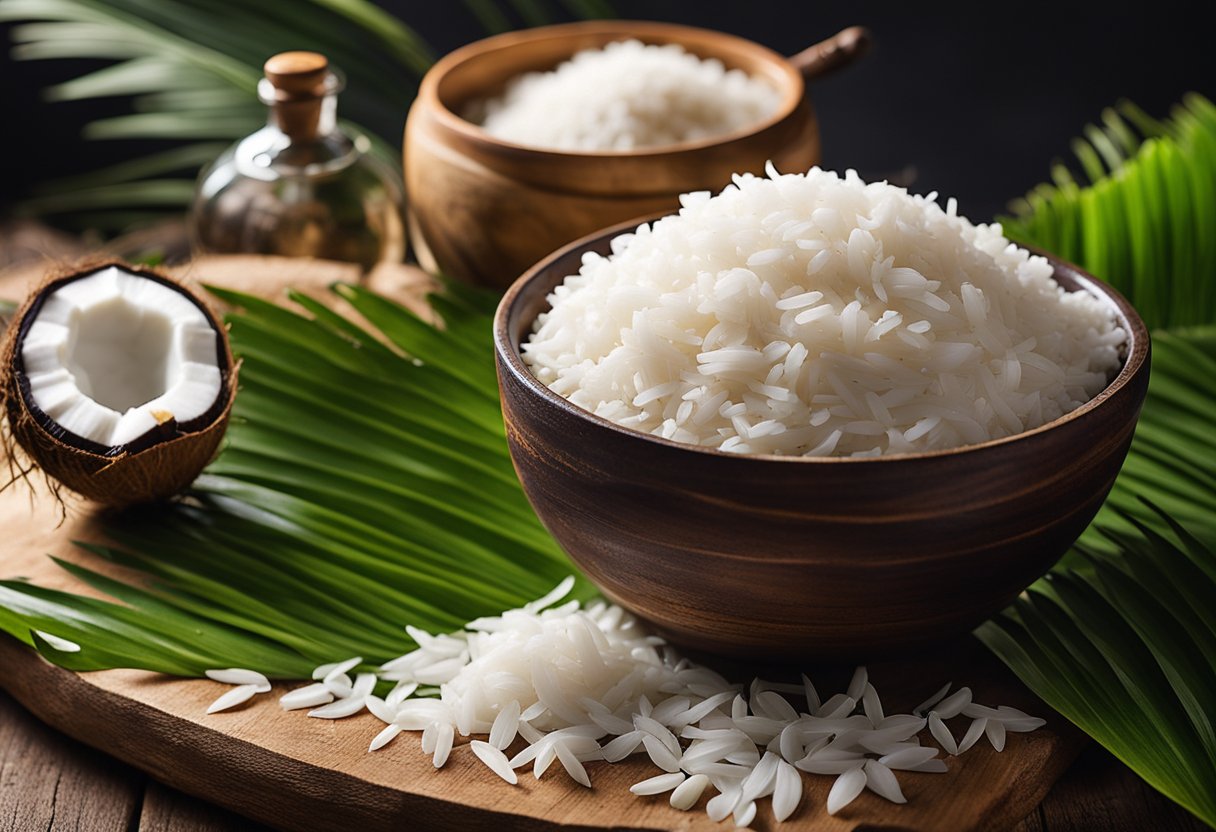
If you want to explore more about this dish, there are many external resources available. Here are a few links that you might find helpful:
- Minimalist Baker’s Perfect Coconut Rice: This recipe from Minimalist Baker uses a secret ingredient to make the perfect dish. The recipe includes step-by-step instructions and photos to help you make the perfect rice every time.
- Ambitious Kitchen’s How to Make The Best Coconut Rice: This recipe from Ambitious Kitchen is a simple and easy way to make it. The recipe includes tips on how to get fluffy rice every time.
- RecipeTin Eats’ Coconut Rice (fluffy, not gluey!): This recipe from RecipeTin Eats shows you how to make fluffy dish without it being gluey. The recipe includes tips on how to get the perfect texture and flavor.
- Just a Taste’s The Best Creamy Coconut Rice: This recipe from Just a Taste shows you how to make the best creamy dish. The recipe includes tips on how to get the perfect texture and flavor.
- A Couple Cooks’ Easy Coconut Rice: This recipe from A Couple Cooks is a simple and easy way to make it. The recipe includes tips on how to get fluffy rice every time.
These links provide a variety of recipes and tips for making This dish. Whether you’re a beginner or an experienced cook, you’re sure to find something that will help you make the perfect dish.
More FAQs
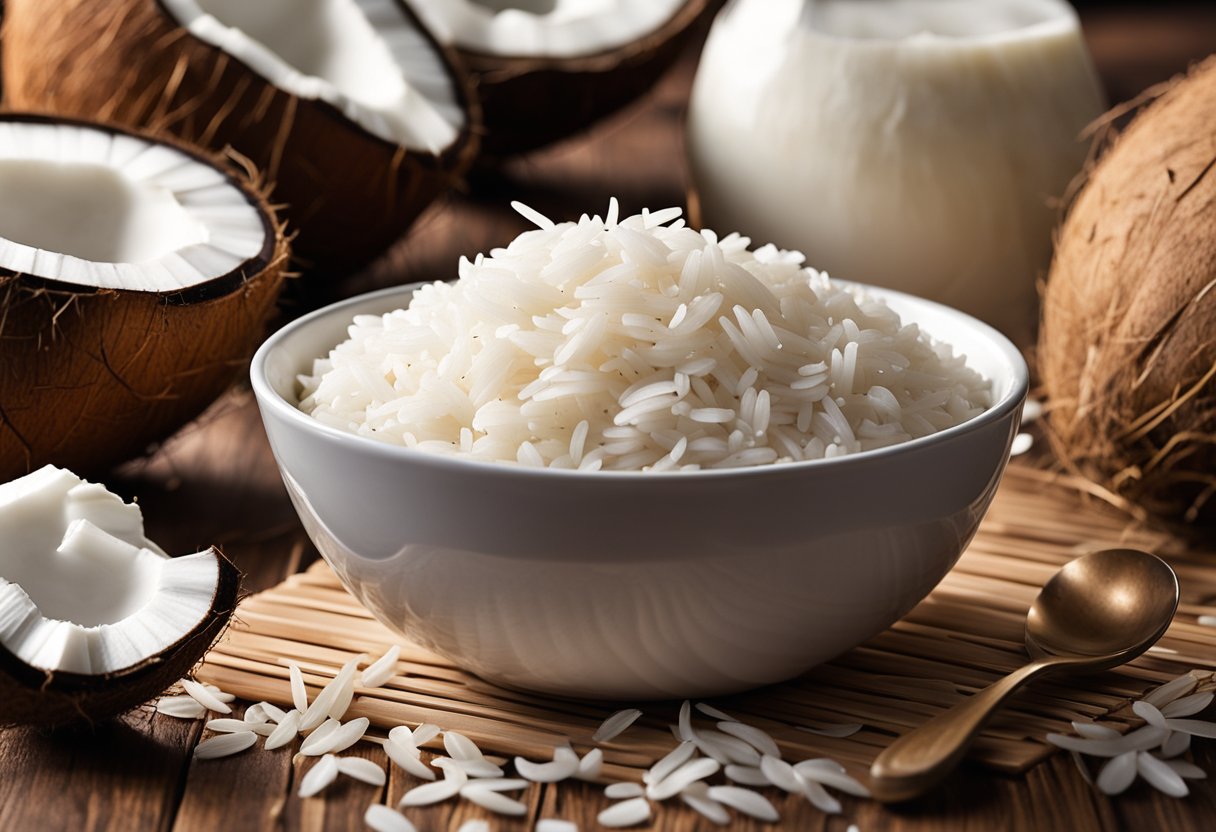
What goes good in coconut rice?
It is a versatile dish that can be paired with a variety of foods. It is a great side dish for curries, stews, and roasted meats. You can also add vegetables like peas, carrots, and bell peppers to give it a more colorful and nutritious twist. For a more tropical flavor, try adding diced pineapple or mango to your dish.
How long will coconut rice last?
It can last up to four days when stored properly in an airtight container in the refrigerator. However, it is best to consume it within two days to ensure maximum freshness and flavor. If you want to store it for a longer period, you can freeze it for up to three months. When reheating, add a splash of water or coconut milk to keep it from drying out.
Why is it called coconut rice?
It is called so because it is made with coconut milk instead of water. The coconut milk gives the rice a creamy and slightly sweet flavor that complements the other ingredients in the dish. It is a popular dish in Southeast Asia, especially in Thailand, where it is known as “Khao Man Gai.”
Why does my coconut rice come out mushy?
It can turn out mushy if it is cooked for too long or if there is too much liquid in the pot. To avoid this, make sure to measure the rice and liquid accurately and follow the cooking instructions carefully. Also, avoid stirring the rice too much while it is cooking, as this can break the grains and make it mushy. If your coconut rice still turns out mushy, try spreading it out on a baking sheet and letting it cool for a few minutes before serving. This will help to dry it out and make it fluffier.
Conclusion
In conclusion, This dish is a delicious and versatile dish that can be enjoyed on its own or as a side dish with a variety of meals. With its creamy texture and subtle coconut flavor, it is a great way to add some tropical flair to your meal.
When making This dish, it is important to use the right type of rice and to balance the ratio of it and water. Jasmine rice is the most commonly used rice for coconut rice, but other types of rice such as basmati or long-grain rice can also be used.
To make the perfect dish, start by rinsing the rice thoroughly and soaking it for at least 30 minutes. Then, cook it in a mixture of coconut milk and water until it is tender and fluffy. You can also add other ingredients such as shredded coconut or pandan leaves to enhance the flavor of the dish.
This dish is a great accompaniment to a wide range of dishes, from spicy curries to grilled meats and seafood. It is also a popular choice for special occasions and celebrations in many parts of the world. Whether you are a fan of Asian cuisine or simply looking for a new and delicious side dish, it is definitely worth a try.
Print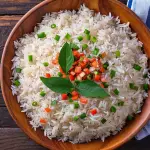
Tasty Coconut Rice Recipe
- Total Time: 25 minutes
- Yield: 4 servings 1x
- Diet: Vegan
Description
Coconut Rice
Ingredients
- 1 cup basmati rice
- 1 cup coconut milk
- 1 cup water
- 1 tablespoon coconut oil
- 1/2 teaspoon salt
- 1/4 cup shredded coconut (optional, for garnish)
- Fresh cilantro or mint leaves for garnish (optional)
Instructions
- Rinse the basmati rice under cold water until the water runs clear.
- In a saucepan, combine the rinsed rice, coconut milk, water, coconut oil, and salt.
- Bring the mixture to a boil over medium-high heat.
- Reduce the heat to low, cover the saucepan with a tight-fitting lid, and simmer for 15-20 minutes or until the rice is tender and the liquid is absorbed.
- Once cooked, fluff the rice with a fork to separate the grains.
- Optional: In a dry pan over medium heat, toast the shredded coconut until golden brown. Sprinkle the toasted coconut over the cooked rice for added flavor and texture.
- Garnish the coconut rice with fresh cilantro or mint leaves if desired.
- Serve the coconut rice as a side dish to complement your favorite Asian or tropical main courses.
Notes
This coconut rice recipe provides a deliciously fragrant and slightly sweet side dish that pairs perfectly with a variety of Asian and tropical-inspired meals. Customize it by adding toasted shredded coconut for a delightful crunch. Serve alongside curries, grilled meats, or seafood for a flavorful culinary experience.
- Prep Time: 5 minutes
- Cook Time: 20 minutes
- Category: Side Dish
- Method: Simmering
- Cuisine: Asian
Nutrition
- Serving Size: 1/2 cup cooked rice
- Calories: 200
- Sugar: 0g
- Sodium: 300mg
- Fat: 10g
- Carbohydrates: 25g
- Fiber: 1g
- Protein: 2g
- Cholesterol: 0mg
Keywords: Coconut Rice
